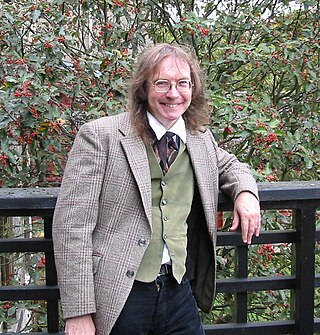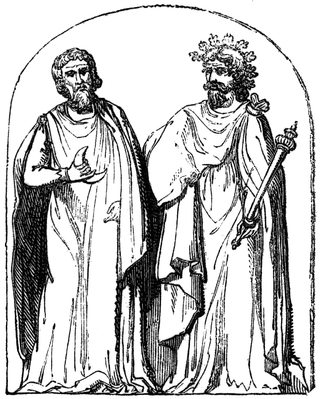Related Research Articles

James Hutton was a Scottish geologist, agriculturalist, chemical manufacturer, naturalist and physician. Often referred to as the "Father of Modern Geology," he played a key role in establishing geology as a modern science.

Margaret Alice Murray was an Anglo-Indian Egyptologist, archaeologist, anthropologist, historian, and folklorist. The first woman to be appointed as a lecturer in archaeology in the United Kingdom, she worked at University College London (UCL) from 1898 to 1935. She served as president of the Folklore Society from 1953 to 1955, and published widely over the course of her career.

Charles II was King of Scotland from 1649 until 1651 and King of England, Scotland, and Ireland from the 1660 Restoration of the monarchy until his death in 1685.

Ley lines are straight alignments drawn between various historic structures, prehistoric sites and prominent landmarks. The idea was developed in early 20th-century Europe, with ley line believers arguing that these alignments were recognised by ancient societies that deliberately erected structures along them. Since the 1960s, members of the Earth Mysteries movement and other esoteric traditions have commonly believed that such ley lines demarcate "earth energies" and serve as guides for alien spacecraft. Archaeologists and scientists regard ley lines as an example of pseudoarchaeology and pseudoscience.
The Hutton Inquiry was a 2003 judicial inquiry in the UK chaired by Lord Hutton, who was appointed by the Labour government to investigate the controversial circumstances surrounding the death of David Kelly, a biological warfare expert and former UN weapons inspector in Iraq.

Lord Howe Island is an irregularly crescent-shaped volcanic remnant in the Tasman Sea between Australia and New Zealand, part of the Australian state of New South Wales. It lies 600 km (320 nmi) directly east of mainland Port Macquarie, 780 km (420 nmi) northeast of Sydney, and about 900 km (490 nmi) southwest of Norfolk Island. It is about 10 km (6.2 mi) long and between 0.3 and 2.0 km wide with an area of 14.55 km2, though just 3.98 km2 of that comprise the low-lying developed part of the island. The island is named after Richard Howe, 1st Earl Howe.

Ronald Edmund Hutton is an Indian-born English historian specialising in early modern Britain, British folklore, pre-Christian religion, and modern paganism. A professor at the University of Bristol, Hutton has written over a dozen books, often appearing on British television and radio. He held a fellowship at Magdalen College, Oxford, and is a Commissioner of English Heritage.

Lauren Hutton is an American model and actress. Born and raised in the southern United States, Hutton relocated to New York City in her early adulthood to begin a modeling career. Though she was initially dismissed by agents for a signature gap in her teeth, Hutton signed a modeling contract with Revlon in 1973, which at the time was the biggest contract in the history of the modeling industry.

Matthew Hutton (1529–1606) was archbishop of York from 1595 to 1606.

The Mari Lwyd is a wassailing folk custom found in South Wales. The tradition entails the use of an eponymous hobby horse which is made from a horse's skull mounted on a pole and carried by an individual hidden under a sheet.

Captain Frederick Wollaston Hutton was an English-born New Zealand scientist who applied the theory of natural selection to explain the origins and nature of the natural history of New Zealand. Whilst an army officer, he embarked on an academic career in geology and biology, to become one of the most able and prolific nineteenth century naturalists of New Zealand.

Matthew Hutton was a high churchman in the Church of England, serving as Archbishop of York (1747–1757) and Archbishop of Canterbury (1757–1758).

Richard Heron Avis Hutton was an American amateur and professional wrestler. He was a three-time NCAA champion and, as a professional, held the NWA World Heavyweight Championship, making him a one-time world champion in professional wrestling.

The Hoarstones, or Hoar Stone Circle, is a stone circle in the civil parish of Chirbury with Brompton in the English county of Shropshire. The Hoarstones are part of a tradition of stone circle construction that spread throughout much of Britain, Ireland, and Brittany during the Late Neolithic and Early Bronze Ages, over a period between 3300 and 900 BCE. The purpose of such monuments is unknown.

The Museum of Witchcraft and Magic, formerly known as the Museum of Witchcraft, is a museum dedicated to European witchcraft and magic located in the village of Boscastle in Cornwall, south-west England. It houses exhibits devoted to folk magic, ceremonial magic, Freemasonry, and Wicca, with its collection of such objects having been described as the largest in the world.
The Sand Hutton Miniature Railway was a miniature gauge estate railway serving the estate of Sir Robert Walker, the Fourth Baronet of Sand Hutton, Yorkshire, England.
Sauerbruch Hutton is an international agency for architecture, urban planning and design. It was founded in London in 1989 and is now based in Berlin, Germany. The practice is led by Matthias Sauerbruch, Louisa Hutton and Juan Lucas Young.

A druid was a member of the high-ranking priestly class in ancient Celtic cultures. Druids were religious leaders as well as legal authorities, adjudicators, lorekeepers, medical professionals and political advisors. Druids left no written accounts. While they were reported to have been literate, they are believed to have been prevented by doctrine from recording their knowledge in written form. Their beliefs and practices are attested in some detail by their contemporaries from other cultures, such as the Romans and the Greeks.
John Henry Hutton CIE FRAI was an English-born anthropologist and an administrator in the Indian Civil Service (ICS) during the period of the British Raj. The period that he spent with the ICS in Assam evoked an interest in tribal cultures of that region that was of seminal importance. His research work was recognised subsequently with his appointment to the chair of William Wyse Professor of Social Anthropology at the University of Cambridge and with various honours.

Ralph Merrifield was an English museum curator and archaeologist. Described as "the father of London's modern archaeology", Merrifield was a specialist in the archaeology of both Roman London and magical practices, publishing six books on these subjects over the course of his life.
References
- ↑ "Catalogue of the Lansdowne Manuscripts in the British Museum" p240: London; British Museum; 1819
- ↑ Alumni Oxonienses 1500-1714, Horrobin-Hyte
- ↑ Horn, Joyce M.; Smith, David M. (1999), Fasti Ecclesiae Anglicanae 1541–1857, vol. 9, pp. 21–23